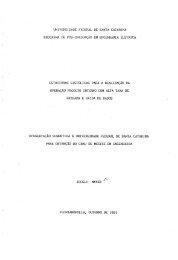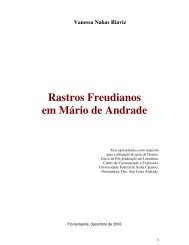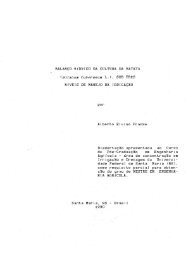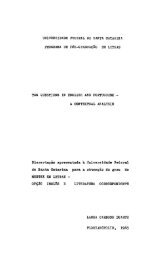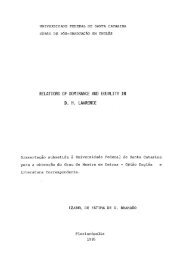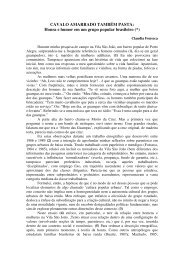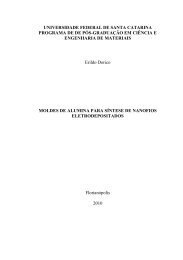a análise de placas laminadas compostas inteligentes
a análise de placas laminadas compostas inteligentes
a análise de placas laminadas compostas inteligentes
Create successful ePaper yourself
Turn your PDF publications into a flip-book with our unique Google optimized e-Paper software.
Abstract<br />
Intelligent structures are systems whose shape and structural and functionals features<br />
may be monitored and modified while in its useful life, allowing to hold the satisfying to<br />
<strong>de</strong>sign requirements and improving the performance. In this scope, laminated composite<br />
structures are very adaptable to this technology, favoring the <strong>de</strong>sign of components with<br />
sensors and actuators embed<strong>de</strong>d within the laminate or bon<strong>de</strong>d on the surfaces. Allied<br />
to the exceptional performance of the composite materials and to the special properties<br />
of materials with coupled response, control systems consist of the link which complete<br />
the chain that <strong>de</strong>fine intelligent systems. Undoubtedly, for the <strong>de</strong>sign of such structures,<br />
there exist the <strong>de</strong>mand for methodology and tools for analysis and verification. Hence,<br />
this work presents a tool implemented un<strong>de</strong>r the Generalized Finite Element Method<br />
philosophy (GFEM) for numerical analysis of composite laminated plates with piezoelectric<br />
sensors and actuators. The GFEM, as a nonconventional Finite Element Method<br />
(FEM) formulation, employs a finite element mesh to build a Partition of Unity, over<br />
which are ad<strong>de</strong>d p-hierarchical refinements with the proposal of enlarge the solution approximation<br />
subspace. The enrichment functions are globally <strong>de</strong>fined and, therefore, such<br />
strategy minimize the mesh importance, factor which has motivated the meshfree methods<br />
<strong>de</strong>velopment. The formulation is based on a Mixed Theory mo<strong>de</strong>l, and in this case,<br />
it is proposed the approximation of electrical unknowns through of the Reddy’s Layerwise<br />
Theory and the approximation of mechanical unknowns through of the Levinson’s<br />
Higher-Or<strong>de</strong>r Shear Deformation Theory, this is, a Equivalent Single Layer Theory. The<br />
complete <strong>de</strong>velopment was conducted for a dynamic system and computational routines<br />
was implemented with FORTRAN 90 language for the static analysis of some mo<strong>de</strong>ls,<br />
whose solutions obtained by others theories constants in the literature were used for the<br />
formulation verification. Moreover, the influence of the way as the essential boundary<br />
conditions are enforced was analyzed, the approximation capability when of the use of<br />
polynomial enrichment -p for distorted meshes and its influence in the primal and dual<br />
fields approximation was showed. The displacement equations and the consistent boundary<br />
conditions were <strong>de</strong>veloped for the mixed mo<strong>de</strong>l employed in the numerical implementation.<br />
A rectangular laminate was analyzed by the GFEM formulation and its results<br />
were compared to the analytical solution, using trigonometrical series, obtained from the<br />
strong form problem.<br />
Keywords: Generalized Finite Element Method, composite laminated plates, piezoelectricity,<br />
Higher-Or<strong>de</strong>r Shear Deformation Theory, Layerwise Theory.



